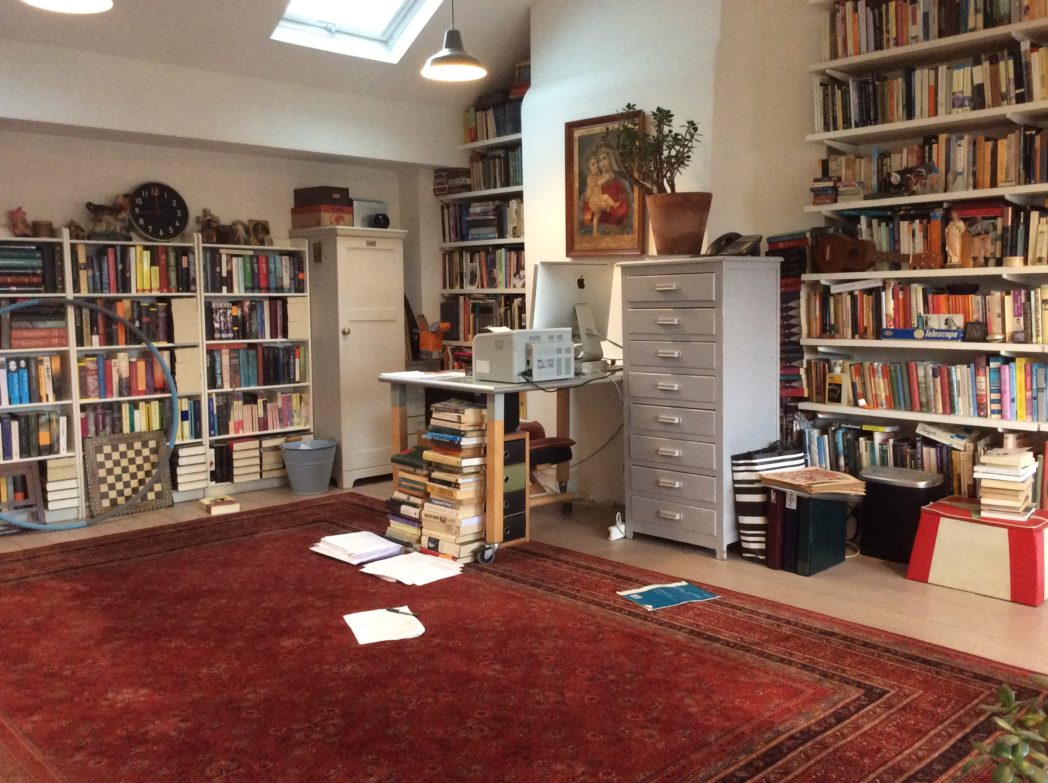Sarah Waters is the award-winning, bestselling author of six novels to date: Tipping the Velvet, Affinity, Fingersmith, The Night Watch, The Little Stranger and her latest novel, The Paying Guests, which was shortlisted for the Baileys Women’s Prize for Fiction in 2015. Today, Waters talks us through her at-home writing space.
I’ve had six writing spaces over the years, as I’ve moved from one house to another. Three of them have been dedicated studies, but three have simply been desks in the corner of the bedroom, and the latter, I’ve found, have worked just as well for me as the former: all I really need, I think, is a flat surface for the computer and some peace and quiet. Probably a broom cupboard would do.
As it happens, though, the study I have at the moment is huge, taking up the whole top floor of our terraced house, with windows on one side and skylights on the other so that it’s light, and airy – and I must admit, it’s wonderful to have enough space to pace around in, with a floor I can spread things out on (including, at weary moments, myself). The view is a classic London one: narrow back gardens, brick walls, slate roofs, gasworks in the distance. There are thirty-nine creaking steps down to the kitchen and the loo.
The desk looks messy, but is pretty organised. For the whole of last year I had it on the other side of the room, close to one of the windows; I moved it to this new spot after reading some online articles on feng shui for writers, and I find I do work better facing the entrance to the room, in what they call ‘the command position’… Not that, if you asked me, I would say I believed in feng shui – but there’s an element to writing fiction that feels so chancy and mysterious that you have to propitiate your gods, I think, in any way that feels right. Among the icons and Sacred Hearts on the bookshelves behind the desk there’s a picture of St Francis de Sales, patron saint of writers. I prayed so often to him while working on my last novel that I swore that when it was finished I would make a pilgrimage of thanks to his grave. I did, as well.
The printer’s a bit long-suffering. I write on screen, but edit on paper – I find I can’t judge a piece of writing until I’ve seen it printed out, preferably mocked up to look like the pages of a book – so I get through a lot of paper and try to print on any old bits I can, stuffing them in, causing jams… The hula hoop is a weighted one: I must look rather ludicrous as I swivel about inside it, but it’s good for shaking things up at the end of the day. More often, though, when I’ve turned off the computer I leave the study completely and go for a long walk. If the day’s been a good one I’ll still have the book in my head as I go, the words fizzing and sparking – it’s almost too much, sometimes, that kind of excitement; it wants to bubble out, like inappropriate laughter. If the day’s been less productive the walking is helpful in a different way: a comfort, a loosening up, a chance to reflect on what’s not working, a change of gear.
There are a lot of books in this room – about sixteen hundred, I think. When I was a child, the only books I collected were Dr Who novelisations: I had so many that my sister’s kindly boyfriend, Jeff, made me a little bookcase for them. I thought myself a real literary sophisticate with that bookcase, and if I had know then that I would one day own a room with all its walls covered in bookshelves I might have spontaneously combusted; there’s a part of me, even now, that looks at all those books and thinks: Wow, I must be really brainy! But, I don’t know. They’re a bit of a mixed blessing. There are a few I dip into often.
There are many I’ve never re-read, but just the sight of their spines makes a little light go on inside me… But oh, the dust! I struggle with it. And I fret about the books fading, in my lovely sunlit room. (I recently stuck an anti-UV window film over the skylights, which has eased my mind a bit.) I worry about the weight of them, too. Some of them are in free-standing cases, and our house is very old: I have a persistent, morbid anxiety that one day they’re going to plunge through the floor, land on someone’s head and kill them.
But perhaps this sort of worrying is just a displacement of the larger anxieties of a writer: Am I any good? How much longer before I’m found out? OK, I pulled it off last time, but that doesn’t give me any confidence that I’ll be able to do it again… The writing room sees it all: the lonely terror, the black despair – but also the bursts of creativity, the breakthroughs, the elation, as well as, more routinely, the wandering thoughts, the fidgeting, the yawns. It also sees some staggeringly terrible clothes – clothes so saggy, so stained, so cosy and over-worn that they belong to a special category of badness. That’s a series still to be written, I think: writers’ outfits. My partner has instructions to bury me in mine.
Sarah Waters’ Writers’ Room piece is a part of a Wales Arts Review series.













